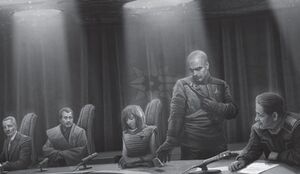Operation EXODUS
This article needs to be updated with material from Handbook: Major Periphery States, Historical: Liberation of Terra Volume 2, Twilight of the Clans. Once these titles clear the Moratorium period, or if they already have, please consider revisiting this article and updating it with the new material. |
Operation EXODUS refers to the departure of the Star League Defense Force from the Inner Sphere in 2784 following the collapse of the Star League. Under the command of Aleksandr Kerensky, the Exodus Fleet traveled for many hundreds of light-years before eventually discovering and settling on the Pentagon Worlds. Their descendants would go on to become the Clans and return to the Inner Sphere as conquerors during Operation REVIVAL.
Contents
History[edit]
Amongst the Rubble[edit]
With the liberation of Terra and the end of the Amaris Civil War, General Kerensky and his close friend General Aaron DeChavilier discussed what would come next. Both men knew that House Cameron was dead and that the Great Houses would rather pick over the Terran Hegemony's carcass than rebuild it. DeChavilier, half-jokingly, made the suggestion that the SLDF simply flee into deep space and found their own colonies from which to watch the coming conflagration. Though not immediately acted upon, the suggestion would go on to serve as the basis for what eventually transpired.[1]
Regardless of their private musings many within the Inner Sphere took heart in the belief that General Kerensky, his fame legendary at that point, would assume the position of First Lord. When the High Council reconvened amid the ruins of Unity City on 10 October 2780, however, they proved Kerensky's suspicions correct. Immediately one of the few things they could agree upon (besides appointing Jerome Blake to rebuild the League's communication network) was that Kerensky would not be elected to the position. Instead eight days later they stripped Kerensky of his title as Protector of the Star League, much to the furious protestations of their own citizens, and ordered that Terra be demilitarized with all SLDF units returning to their peacetime positions. The General's only response was to meet the Great Lords in Throne Room at Unity City and plead that Republican forces be treated with leniency before leaving for the SLDF's temporary headquarters on New Earth.[2]
Within the week General DeChavilier had informed Kerensky that the SLDF stood ready to help him overthrow the High Council and assume the title of First Lord. Kerensky's response was that he was too tired for treason and would remain loyal to the Star League until the very end. After ten months of exhausting and furious debate though it soon became apparent that the High Council was at an impasse. On 12 August 2781 they released a curt statement detailing their inability to come to a decision and that the Star League would be dissolved.[2]
Many believed that Kerensky now had all the justification needed to seize power, but instead the General spent the next two years shuttling between the House Lords trying to reconcile their differences. Kerensky's attempts fell on deaf ears, despite the House Lords' own citizens backing his effort, and instead they began increasing the size of their militaries. This included recruiting former Republican soldiers, offering wealth and even titles and land for their services, and in August 2783 their efforts turned to the SLDF itself; when Kerensky objected to these cynical machinations they stripped him of his rank as Commanding General. The defection of the 91st Heavy Assault Regiment en masse to the Federated Suns a month later was the final straw for Kerensky.[1][2]
The Fateful Departure[edit]
Kerensky made his decision to implement Operation EXODUS around the time of the Ninety-first's defection and preparations began immediately. The General would confide his intentions to Jerome Blake at the opening of the Hilton Head HPG complex that same year, and while angered and confused by his decision the Minister of Communications agreed to suppress any knowledge of the EXODUS plan from the Great Houses. On 14 February 2784, in a meeting at an empty wooden warehouse on Terra, Kerensky and the rest of the High Command outlined their intentions to over two hundred high-ranking officers, that the heart and soul of the Star League still lived on inside each soldier and that the only way to preserve it was for them to escape the coming storm. While Kerensky's speech drew standing ovations, a small group disapproved, refusing to abandon the Terran Hegemony and the Inner Sphere. Kerensky responded by instituting a poll in late February of every remaining member of the SLDF and giving them the option to join the mission or stay behind.[2][3][4][5][6]
In the end over eighty percent of the force decided to go, while a number of units either joined the houses directly or as mercenaries. These troops, the remaining fourteen percent, were the Eridani Light Horse, Fifteenth Dracon Regiment, Blue Star Irregulars, Screaming Eagles, Bolton's Rangers, 802 Independent Aerospace, and the Fourth Tau Ceti Rangers. The bulk of those who refused began to coalesce around the 151st Royal BattleMech Division and its outspoken CO Lauren Hayes.
Concerned at leaving Hayes and her sizable SLDF forces without direction and recalling Jerome Blake's pleas for assistance in the reconstruction of the Hegemony, Kerensky brokered a deal whereby Hayes could remain but had to obey Blake and the Ministry of Communications as the last vestige of the Star League, hidden from the Great Houses.[2][3][4][5][6]
The Black Warriors—a Star League-turned-merc unit—was left behind accidentally, due a communication error. They eventually turned to piracy.[7]
Another unit left behind (due to mechanical problems) was the 295th BattleMech Division. They attempted, in vain, to follow the Exodus Fleet; eventually they self-stranded on the uninhabited Buffalo Meadows, dying off within a few decades.[8][9]
Furious preparations began for the coming Exodus. Damaged ships underwent hectic repairs at many League shipyards, while all available JumpShips produced by commercial manufacturers were bought up. Military bases were stripped of all supplies, families made ready to move and massive amounts of resources bought on the open market, sometimes directly from the House realms themselves. For their part the House Lords, apart from Coordinator Minoru Kurita, were oblivious to these maneuvers and none knew their true purpose.[2]
On 8 July General Kerensky gave his famous "Exodus" order and the huge force assembled at New Earth and fifty other star systems made the jump. The ships made a beeline for the Draconis Combine, stopping only in star systems with sizable SLDF bases to strip them of supplies and cryptically replying when asked as to their mission that they were "out on extended maneuvers." Along the way the convoys also picked up civilians, many having suffered greatly during the civil war and disposed to leave everything behind, while others were "invited" to join for their skill set. Records kept by the Clans would later hint some may have been less-than-willing participants.[10][11]
Despite its diminished size the SLDF was still vastly stronger than any of the Houses' forces and all feared that these mysterious maneuvers were part of a new campaign of revenge and conquest. Coordinator Kurita became especially perturbed when the convoys' routes became clear, knowing full well how he had mistreated Kerensky and been friendly with Stefan Amaris during the civil war. Harboring suspicions that the SLDF was planning on leaving the Inner Sphere and knowing something of the General's mindset, he knew it was better to remain calm than to panic and ordered his forces to not attack. As the SLDF passed peacefully through Combine space his convictions were proved correct, and the convoys began to assemble at their rendezvous point above New Samarkand on 2 October, with the entire force assembled ten days after.[10]
A pair of SLDF bases were located on the planet, each with extensive wilderness surrounding them. For the next three weeks the members of the fleet were shuttled back and forth from their ships to the planet to rest for the coming journey, their campfires dotting the landscape as they prepared for the ordeal ahead. It was also during this time that Kerensky fulfilled his last duty as Protector and delivered the body of Amaris to the University of New Samarkand's medical school. Finally on 5 November the Exodus fleet began to leave the system, its sheer size requiring a full day for every ship to leave (with the last being the flagship McKenna's Pride). Making its way through the Periphery, its last confirmed sighting would be in orbit above Gutara V before disappearing from the Inner Sphere forever.[6][10][12]
The Exodus Road[edit]
The fleet made slow progress as it moved out from the Periphery and into deep space. Picket ships scouted ahead of the main fleet, looking for worlds from which to resupply, while WarShips and scout JumpShips operated in the vanguard, flanks and rearguard. Several ships would be lost due to mechanical failure and jump accidents or simply disappeared during this time—including an advanced prototype, the SLS Manassas, separated from the fleet to scout for possible pursuers, though the ship wasn't destroyed—while rationing was a daily part of life.[13] People accepted these hardships at first in the belief that Kerensky was leading them to a better life, but as the months dragged on tensions began to develop among the crews and families.[14]
The fleet stopped at several planets to resupply water and maybe also food (ComStar later discovered one of these planets, codenamed Barbados).
This dissension finally came to a head on 19 August 2785 when a task group led by the WarShip Prinz Eugen mutinied and threatened to return to the Inner Sphere. Kerensky dealt with the situation in a decisive if brutal manner, but rumors that the fleet was simply aimlessly wandering through deep space continued to spread. In response the General issued General Order 137 in an attempt to justify his actions and boost morale among the people. The explanation had the desired effect and did much to return a sense of normality to the fleet, but Kerensky was well aware their journey would have to end soon.[14]
It is not known whether General Kerensky had a particular destination in mind, or whether outside factors forced him to cut the journey short or extend it longer than planned. By July 2786, tensions were again rising to dangerous levels, such that Aleksandr's son Nicholas believed another mutiny was likely soon. On 24 August, when the fleet reached a cluster of five marginally habitable worlds—the Pentagon Cluster—Kerensky announced that the fleet had come to the end of their journey. Though the Clans would celebrate that day as Founding Day, the actual planetfalls wouldn't occur until early September as the SLDF science corps surveyed the worlds. Within ten days the first of the engineering corps began setting up prefabricated buildings, and within a week the first colonists set foot on Pentagon soil. The Exodus was over.[11][14]
The Pursuers[edit]
Kerensky feared some Inner Sphere states would attempt to follow the Exodus Fleet to try and recruit former SLDF units to fight for the House Lords; he was right. Fearing his return, all five Successor Lords diverted resources into extensive research about the fate of the Exodus Fleet. Some even tapped into independent operations of private exploration groups, but in the end, only Houses Davion and Kurita launched great expeditions. The first and most desperate was the Church Expedition, which followed them to the Gutara system before losing track. The Federated Suns and the Combine each launched two more expeditions over the next century. Nothing was found; Kerensky's efforts to cover their tracks proved successful.[15]
Order of Battle[edit]
At the end of the civil war only 113 Divisions of the SLDF remained.[4] Of these units over a hundred agreed to follow Kerensky: thirty-two BattleMech divisions, seventy-six infantry divisions, and sixty-three independent regiments. A total of nearly six million personnel, a third of which were soldiers and the rest civilians, were carried in 1,349 JumpShips, 402 WarShips and over 5,000 DropShips.[10][14]
Armored Divisions[edit]
BattleMech Divisions[edit]
List of 32 of a reported 32 Divisions.
- 11th Royal BattleMech Division
- 15th BattleMech Division
- 26th Royal BattleMech Division
- 39th Royal BattleMech Division
- 81st BattleMech Division
- 89th BattleMech Division
- 116th BattleMech Division
- 131st BattleMech Division
- 135th Royal BattleMech Division
- 146th Royal BattleMech Division
- 149th BattleMech Division
- 150th Royal BattleMech Division
- 154th BattleMech Division
- 164th BattleMech Division
- 168th BattleMech Division
- 173rd BattleMech Division
- 189th BattleMech Division
- 218th BattleMech Division
- 229th BattleMech Division
- 271st BattleMech Division
- 275th BattleMech Division
- 299th Royal BattleMech Division
- 308th BattleMech Division
- 309th Royal BattleMech Division
- 315th BattleMech Division
- 316th Royal BattleMech Division
- 328th Royal BattleMech Division
- 331st Royal BattleMech Division
- 341st Royal BattleMech Division
- 342nd Royal BattleMech Division
- 349th Royal BattleMech Division
- 382nd BattleMech Division
Infantry Divisions[edit]
72 of a reported 76 Infantry Divisions involved.
- 11th Infantry Division
- 14th Infantry Division
- 35th Infantry Division
- 44th Royal Infantry Division
- 49th Infantry Division
- 50th Royal Infantry Division
- 53rd Infantry Division
- 72nd Infantry Division
- 1st Jump Infantry Division
- 12th Jump Infantry Division
- 17th Jump Infantry Division
- 30th Jump Infantry Division
- 59th Jump Infantry Division
- 60th Jump Infantry Division
- 61st Royal Jump Infantry Division
- 65th Jump Infantry Division
- 80th Royal Jump Infantry Division
- 82nd Royal Jump Infantry Division
- 86th Jump Infantry Division
- 101st Jump Infantry Division
- 106th Royal Jump Infantry Division
- 145th Jump Infantry Division
- 159th Jump Infantry Division
- 185th Jump Infantry Division
- 206th Jump Infantry Division
- 208th Jump Infantry Division
- 210th Jump Infantry Division
- 1007th Jump Infantry Division
- 1st Royal Mechanized Infantry Division
- 9th Mechanized Infantry Division
- 13th Royal Mechanized Infantry Division
- 16th Mechanized Infantry Division
- 17th Royal Mechanized Infantry Division
- 24th Mechanized Infantry Division
- 26th Mechanized Infantry Division
- 27th Royal Mechanized Infantry Division
- 34th Royal Mechanized Infantry Division
- 41st Mechanized Infantry Division
- 46th Mechanized Infantry Division
- 49th Mechanized Infantry Division
- 50th Royal Mechanized Infantry Division
- 65th Royal Mechanized Infantry Division
- 67th Mechanized Infantry Division
- 68th Mechanized Infantry Division
- 111th Mechanized Infantry Division
- 120th Royal Mechanized Infantry Division
- 129th Mechanized Infantry Division
- 131st Royal Mechanized Infantry Division
- 132nd Royal Mechanized Infantry Division
- 142nd Mechanized Infantry Division
- 146th Mechanized Infantry Division
- 147th Mechanized Infantry Division
- 157th Royal Mechanized Infantry Division
- 159th Royal Mechanized Infantry Division
- 164th Mechanized Infantry Division
- 169th Royal Mechanized Infantry Division
- 172nd Mechanized Infantry Division
- 174th Mechanized Infantry Division
- 183rd Royal Mechanized Infantry Division
- 191st Mechanized Infantry Division
- 192nd Mechanized Infantry Division
- 194th Mechanized Infantry Division
- 196th Mechanized Infantry Division
- 212th Mechanized Infantry Division
- 226th Royal Mechanized Infantry Division
- 237th Mechanized Infantry Division
- 242nd Royal Mechanized Infantry Division
- 255th Royal Mechanized Infantry Division
- 257th Mechanized Infantry Division
- 279th Royal Mechanized Infantry Division
- 294th Mechanized Infantry Division
- 300th Mechanized Infantry Division
Independent Regiments[edit]
25 of reportedly 63 Independent Regiments.
- 587th Royal Artillery Regiment
- 458th Battle Regiment
- 22nd Royal CAAN Marine Regiment
- 31st Royal CAAN Marine Regiment
- 35th Royal CAAN Marine Regiment
- 16th Dragoon Regiment
- 20th Dragoon Regiment
- 29th Royal Dragoon Regiment
- 74th Royal Dragoon Regiment
- 102nd Dragoon Regiment
- 108th Dragoon Regiment
- 111th Dragoon Regiment
- 121st Royal Dragoon Regiment
- 129th Dragoon Regiment
- 131st Dragoon Regiment
- 138th Dragoon Regiment
- 146th Dragoon Regiment
- 200th Dragoon Regiment
- 261st Dragoon Regiment
- 300th Dragoon Regiment
- 315th Dragoon Regiment
- 345th Dragoon Regiment
- 367th Royal Dragoon Regiment
- 405th Royal Dragoon Regiment
- 38th Hussar Regiment
References[edit]
- ↑ 1.0 1.1 The Clans: Warriors of Kerensky, p. 6
- ↑ 2.0 2.1 2.2 2.3 2.4 2.5 The Star League, p. 95
- ↑ 3.0 3.1 Masters and Minions: The StarCorps Dossiers, p. 205: "ComStar - Network Online"
- ↑ 4.0 4.1 4.2 ComStar, pp. 11–13: "History - Birth of ComStar - Operation Exodus - The First Circuit - Operation Silver Shield"
- ↑ 5.0 5.1 Field Manual: ComStar, p. 11: "Shadow Games"
- ↑ 6.0 6.1 6.2 Historical: Liberation of Terra Volume 2, p. 115: "Aftermath - Crisis in the SLDF - Planning for Exile - Disposing of the Usurper"
- ↑ Field Manual: Periphery, p. 98
- ↑ The Periphery (2nd Edition), p. 91
- ↑ Requiem for a Blue Star, p. 4 (PDF): "Final Stop"
- ↑ 10.0 10.1 10.2 10.3 The Star League, p. 96
- ↑ 11.0 11.1 The Clans: Warriors of Kerensky, p. 8
- ↑ House Davion (The Federated Suns), p. 59: "History - Under the Star League - Dissolution - Amaris's Grave"
- ↑ Living Legends, p. 5
- ↑ 14.0 14.1 14.2 14.3 The Clans: Warriors of Kerensky, p. 7
- ↑ First Succession War, pp. 46–47




